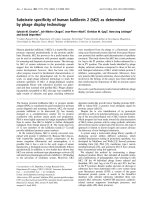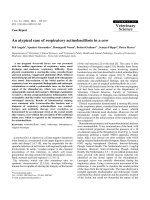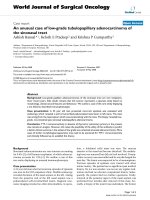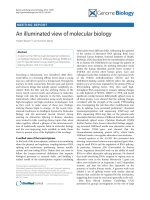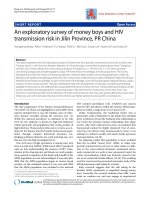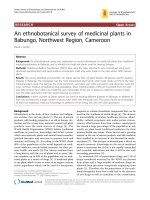Báo cáo y học: " An unusual case of congenital melanocytic nevus presenting as neurocutaneous melanoma coexisting with Tuberous Sclerosis complex: A case report" pot
Bạn đang xem bản rút gọn của tài liệu. Xem và tải ngay bản đầy đủ của tài liệu tại đây (607.13 KB, 5 trang )
CAS E REP O R T Open Access
An unusual case of congenital melanocytic nevus
presenting as neurocutaneous melanoma
coexisting with Tuberous Sclerosis complex: A
case report
Santosh Rai
1
, Piyush Kalakoti
2*
, MM Aarif Syed
2
, Purujit J Thacker
2
, Rishi Jain
1
and Gaurav Kalra
1
Abstract
Introduction: Congenital melanocytic nevi are among the several known risk factors for the development of
melanoma. Neurocutaneous melanosis is a rare, congenital, non-hereditary disorder characterized by the presence
of multiple and/or giant congenital melanocytic nevi. It is a rare condition, with fewer than 200 cases reported in
the literature. Its association with tuberous sclerosis complex, a form of the neurocutaneous syndrome, is an
unusual finding which, to the best of our knowledge, has not been documented in the English literature so far.
Herein we present the first case documenting such an association in a 16-year-old post-pubertal Indian girl.
Case presentation: In this report, we describe the case of a 16-year-old Indian girl who presented to our hospital
with swelling on the scalp which had progressed from the hairline to just above the left brow, causing mechanical
ptosis. She was born with a black-pigmented triangular patch covered with hair over the scalp which had
increased in size over a period of eight years after birth. An X-ray of her skull and ultrasonography revealed soft
tissue swelling in the left temporofrontoparietal region. Magnetic resonance imaging of her brain showed the
presence of 8.99 cm × 2.26 cm abnormal signal intensity involving the scalp, a few small tubers with cortical
dysplasia in the left frontoparietal region with asymmetric dilatation, and the presence of calcified subependymal
nodules within the left lateral ventricle. These findings were suggestive of tuberous sclerosis. A histopathological
examination of the swelling was suggestive of congenital melanocytic nevi. The patient underwent surgery.
Excision of the tumor with primary skin grafting was done, with the graft being taken from the medial aspect of
the right thigh.
Conclusion: This case warrants further research to provide concrete evidence of an association of neurocutaneous
melanoma with tuberous sclerosis complex. Research should be conducted to prove whether this is an unusual
association or a new syndrome. Also, similar cases in other parts of the globe should be documented, as they
would provide substanti al support for such an association.
Introduction
Congenital melanocytic nevi (CMN) are found in
approximately 1% of newborn infants, but 90% of these
nevi are very small. Giant congenital nevi (GCN), giant
hairy nevi and nevocellular nevi represent a special
group of melanocytic lesions that generally cover large
areas of the body a nd carry a p otential risk for the
development of malignant melanoma [1]. A congenital
nevus is one of several known risk factors leading to the
development of melanoma. Fortunately, melanoma
remains an uncommon malignancy in pre-pubertal chil-
dren, with an annual incidence of 0.7 cases per 1 million
children from birth through age nine ye ars. Patients’
concern regarding changing or worrisome-looking nevi
are nonetheless very common. Moreover, by the time a
child reaches adolescence, the incidence of melanoma
increases substantially, with a rate of 13.2 cases per one
million children ages 15 to 19 years [2].
* Correspondence:
2
Pravara Rural Hospital and Rural Medical College, Loni, Maharashtra, 413736,
India
Full list of author information is available at the end of the article
Rai et al. Journal of Medical Case Reports 2011, 5:267
/>JOURNAL OF MEDICAL
CASE REPORTS
© 2011 Rai et al; licensee Bi oMed Central Ltd. This is an Open Access article distributed under the terms of the Creative Commons
Attribution License ( which permits unrestricted use, dis tribution, an d reproduction in
any medium, provided the original work is properly cited.
Neurocutaneous melanosis (NCM) is a congenital,
non-he reditary disorder defined by the presence of mul-
tiple and/or GCMN associated with abnormal melanin
deposits in the brain and/or leptomeninges documented
by magnetic resonance imaging (MRI) or autopsy [3-6].
It is a rare condition, with fewer than 200 cases reported
in the literature. Although there is proliferation of mela-
nocytes in the skin and arachnoid matter, there is cur-
rently no embryological explanation for the genesis of
this disorder. Approximately one-half of all patients
with NCM eventually develop melanoma of the central
nervous system [7]. However, the presence of tuberous
sclerosis complex (TSC), a form of the neurocutaneous
syndrome (NCS), concurrently with NCM is an unusual
and rare finding which, to the best of our knowledge,
has not been documented in the literature so far. Herein
we present the first such association in a 16-year-old
girl.
Case presentation
A 16-year-old Indian girl presented to our hospital with
swelling on the scalp. She was born with a black-pig-
mented triangular patch over the scalp covered with
hair as well as multiple black hairy patches on her extre-
mities, back, and most of her anterior trunk. The patch
on the scalp had increased in size over a period of eight
years after birth. Within the past three months, swelling
hadprogressedfromthehairlinetojustabovetheleft
brow, leading to unilateral mechanical ptosis. Upon
applying pressure, there was a scanty, yellowish, non-
foul-smelling discharge that was occasionally blood-
stained and was associated wit h intense itching without
any pain. Her sleep, appetite, bowel, and bladder were
unaltered. Her menarche had begun at the age of 15
years, and her menstrual cycle was normal and regular.
Her birth and developmental history were normal. The
family history was negative for congenital nevi or
melanoma.
The patient’s clinical examination revealed her to be
afebril e, with a pulse rate of 64 beats/minute, a respira-
tory rate of 16 breaths/minute, and blood pressure of
120/70 mmHg. The examination of her cardiovascular
system was normal. Her cranial nerve functions were
normal, and no neurological deficit was found in the
limbs. The plantar response in both the limbs was
flexor. There was no evidence of meningeal irritation.
A local examination revealed a single swelling of 10
cm × 8 cm on the left side of the scalp. The swelling
extended anteroposteriorly from 3 cm in front of the
left parietal eminence to just above the lateral part of
the left supraorbital ridge. The transverse extension was
from the line passing through the left parietal eminence
to the right of the midline (Figure 1). Her local tempera-
ture was not raised, and tenderness was absent. The
surface was irregular, rough with multiple pits, and the
margins were irregular with rounded edges. The swel-
ling was firm i n consistency and mobile. The anterior
part of the swelling overlying the forehead could be
lifted. The underlying skin appeared normal. It was non-
pulsatile with no evidence of impulse on coughing. The
regional lymph nodes were not palpable. Numerous
hairy nevi were present over the scalp, trunk, and limbs.
The patient was referred to the Department of Neuro-
ophthalmology and Otolaryngology for further assess-
ment. Her fundoscopy and visual evoked potentials were
normal. Her otorhinolaryngological evaluations were
normal.
Routine blood investigations showed that her hemo-
globin level was 11.6% and her total leukocyte count
was 4200/mm
3
with relative neutrophilia (80%). Her
serum urea and electrolyte levels were normal. A lumbar
puncture revealed clear cerebrospinal fluid with a nor-
mal cell count and biochemistry and no growth on cul-
ture. Her liver and kidney function tests were within
normal limits. Her electrocardiogram did not show any
abnormal features.
An X-ray of her skull (posteroanterior view) revealed a
soft tissue swelling in the left temporofrontopar ietal
region. Ultrasonography of the swelling showed a large,
homogeneous, hypoechoic, solid 9.4 cm × 6.8 cm × 1
cm lesion in her scalp in th e left frontal region and par-
tially extending into the parietal region on the left side.
The underlying outer table of the skull and diploic
spaces were normal with few hyper-reflective areas scat-
tered throughout the lesion and distal shadowing raising
clinical suspicions of tiny calcified foci. The interface
between the lesion and the scalp was obscured. No
Figure 1 Gross appearance of the lesion. A single swelling of size
10 cm × 8 cm (white arrow) on the left side of the scalp extending
anteroposteriorly from 3 cm in front of the left parietal eminence to
just above the lateral part of the left supraorbital ridge is shown.
The transverse extension from the line passing through the left
parietal eminence to the right of the midline can be seen.
Rai et al. Journal of Medical Case Reports 2011, 5:267
/>Page 2 of 5
significant color flow was noted on a color Doppler
ultrasonogram. These findings were highly sugges tive of
a possible angiofibroma. Power Doppler ultrasonography
showed a highly vascularized lesion.
MRI of her brain (both plain and contrast images) was
done by using a multi-echo, multi-planar technique,
which showed the presence of a 8.99 cm × 2.26 cm
abnormal signal intensity involving the scalp (subcuta-
neous plane within fat) in the left frontoparietal region.
The signal intensit y appeared isointense to hyperintense
on T1-weighted MRI sc ans with few small tubers with
cortical dysplasia in the left frontoparietal region and
asymmetric dilatation of the left ventricle that were
hypointense on T2-weighted MRI and fluid attenuated
inversion recovery (FLAIR) images. Few foci were seen
within the lesion, which appeared hyperintense on T2-
weighted MRI and FLAIR images. The MRI impression
revealed multiple intra-cranial lesions, which included a
benign, homogeneously enhancing, subcutaneous scalp
lesion in left frontoparietal region suggestive of angiofi-
broma; a few calcified subependymal nodules within the
body of the lateral ventricles on the right side; a few
small tubers with cortical dysplasia in the left frontopar-
ietal region; and left maxillary sinusitis (Figure 2). These
radiological findings were highly suggestive of t uber ous
sclerosis. Magnetic resonance angiography revealed the
absence of involvement of any underlying blood vessels.
Microscopic examination of the patient’sscalpswel-
ling revealed the presence of lining keratinized, stratified
squamous epithelium a nd underlying dermis. The epi-
dermis was thinned out with loss of rete pegs. Her der-
mis showed lobules and nests of nevi cells, hair follicles,
sweat glands, and sebaceous glands. There was diffuse
deposition of melanin pigment and the presence of mel-
anocytes around and within the hair follicles and sebac-
eous glands extending up to deep subcutis and
infiltrating the fat (Figure 3). All of these findings were
suggestive of congenital melanocytic nevi.
On correlating these imaging findings with the
patient’s clinical symptoms, surgery was considered.
Excision with primary skin grafting was done (Figure 4).
The graft was taken from the medial aspect of her right
thigh.
Discussion
In 1861, Rokitansky [8] first described NCM in a 1 4-
year-old girl. CNM is a well-known risk factor for the
eventual development of melanoma. CNM are classified
as large (≥ 20 cm), medium (1.5 cm to 19.9 cm), and
small (≤ 1.5 cm) nevi according to their size [9]. The
term “multiple” is used when more than three lesions
arepresent.NCMisthoughttobearesultofanerror
occurring during morphogenesis in the neuroectoderm
[10]; however, its exact pathogenesis is unclear. NCM is
currently diagnosed according to the following criteria
put forth by Kadonaga and Frieden [10] in 1991: (1)
large and/or multiple CMN in association with menin-
geal melanosis or melanoma, (2) no evidence of
Figure 2 Magnetic resonance imaging findings. These MRI scans
show a single 8.99 cm × 2.26 cm abnormal signal intensity
involving the scalp in the left frontoparietal region appearing
isointense to hyperintense on T1-weighted images (thin white
arrow) with few calcified subependymal nodules within the body of
the lateral ventricles on the right side (black arrow), a few small
tubers with cortical dysplasia (thick white arrow) in the left
frontoparietal region, and left maxillary sinusitis.
Figure 3 Pathologic findings (hematoxylin and eosin stain). This
high-power photomicrograph of the area shows the keratinized,
stratified squamous epithelium (thick black arrow) and the
epidermodermal junction (thick white arrow). The epidermis is
thinned out with loss of rete pegs. The dermis shows diffuse
deposition of melanin pigment (thin white arrow) and the presence
of melanocytes (thin black arrow) around and within the hair
follicles.
Rai et al. Journal of Medical Case Reports 2011, 5:267
/>Page 3 of 5
cutaneous melanoma, exc ept in patients with histologi-
cally benign meningeal lesions, or (3) no evidence of
meningeal melanoma, except in patients with histologi-
cally benign cutaneous lesions. They also found that
66% of NCM patients had large nevi, and the r emaining
34% had numerous pigmented lesions in the absence of
a single, large congenital melanocytic nevus. In their
study, all NCM patients had either posterior midline
nevi or head and neck lesions, which suggest that the
axial distribution is an important risk factor for develop-
ing NCM. Our patient also had a single, large CMN
with an axial distribution over the scalp with no evi-
dence of meningeal melanoma, but she had histologi-
cally benign cutaneous scalp lesions, pointing toward
the diagnosis of NCM.
Clinically, patients may present with a mass lesion or
increased intra-cranial pressure due to hydrocephalus,
cranial nerve paralysis, myelopathy, convulsive seizures,
and so forth [11]. Most cases of melanoma arising
within the GCN occur b efore puberty [12], with a
reported incidence of 8.52% and a lifetime risk in the
range of 2.3% [13-17]. Giant congenital melanocytic nevi
(GMCN) occur in approximately one in 20,000 people,
and about 1 00 cases were reported w orldwide prior to
2000 [3,18,19]. It is recommended that GCMN be
removed soon after the diagnosis because of cosmetic
problems and their propensity for malignant change
[10,18,20-23]. The neurological manifestations of NCM
vary with age [10]. Before the age of two years, the most
common initial clinical signs and symptoms of NCM
are related to increased intra-cranial pressure, includi ng
headache (35%), vomiting (42%), generalized seizures
(48%), increased head circumference (23%), cranial
nerve palsies (26%; in particular cranial nerve VI),
papilledema (10%), and meningeal signs (3%) [24]. The
subset of patients w ith a discrete intra-cranial mass
become symptomatic when they are older (mean age,
12.8 years; age range, birth to 65 years) and are more
likely to develop focal seizures, localized sensorimotor
deficits, difficulties with speech, or psychiatric symptoms
[24]. The prognosis for patients with symptomatic NCM
is poor. Our patient was asymptomatic at the time of
presentation and presented to our hospital only for aes-
thetic reasons.
The present case pointed toward a definite diagnosis
of tuberous sclerosis complex because of two major fea-
tures: calcified subependymal nodules within the body
of the lateral ventricles and cortical tubers as confirmed
by MRI. There was no history suggestive of TSC in her
parents or siblings.
Our patient had congenital giant, hairy melanotic nevi
of the skin (scalp) which had gradually progressed in
size to a cutaneous scalp tumor indicative of melanoma.
NCM is known to be associated with the other NCSs,
such as Sturge-Weber syndrome and von Recklinghau-
sen’s disease. Associations with Dandy-Walker complex,
spinal lipomas, and arachnoid cysts have also been
reported [25,26]. About 100 cases of NCM have been
reported. However , the coexistence of tub erous sclerosis
with NCM is an unusual finding which, to the best of
our knowledge, has not been documented in the litera-
ture so far.
Conclusion
This case warrants further research to provide concrete
evidence of an association of TSC with NCM. Research
should be conducted to prove whether NCM associated
with TSC is an unusual or new syndrome. Also, similar
cases occurring in other parts of the globe should be
documented, as t hey would provide substantial support
for such an association. Genetic and molecular investi-
gations with specific tumor markers sho uld be con-
ducted. However, in the present case, because of the
paucity of facilities in the institution and the financial
const raints on the patient, a detailed investigatio n could
not be performed.
Consent
Written informed consent was obtained from the patient
and the patient’ s next-of-kin for public ation of this case
report and any accompanying images. A copy of the
written consent is available for review by the Editor-in-
Chief of this journal.
Acknowledgements
We acknowledge the contribution of Dr PK Baviskar, MBBS, MS, Professor
and Head, Department of Surgery, Rural Medical College, Loni, India, and Dr
SG Gandage, MD, DMRD, Professor and Head, Department of Radiodiagnosis,
Figure 4 Post-operative photograph of the scalp. A primary skin
graft was placed over the affected area (white arrow) after removal
of the tumor.
Rai et al. Journal of Medical Case Reports 2011, 5:267
/>Page 4 of 5
Rural Medical College, Loni, India, in affirming our clinical diagnosis on the
basis of appropriate neuroimaging.
Author details
1
Department of Surgery, Rural Medical College, Loni, Maharashtra, 413736,
India.
2
Pravara Rural Hospital and Rural Medical College, Loni, Maharashtra,
413736, India.
Authors’ contributions
SR, PK, and MMAS participated in the clinical diagnosis, sequence alignment,
and drafting of the manuscript and made useful contributions to the review
of the literature. GK, RJ, PK, and MMAS were the team of operating
surgeons. PK and MMAS participated in writing the Discussion section. PK
and MMAS and PJT helped in the revision of the manuscript. All authors
read and approved the final manuscript.
Competing interests
The authors declare that they have no competing interests.
Received: 27 September 2010 Accepted: 1 July 2011
Published: 1 July 2011
References
1. Fox H: Neurocutaneous melanosis. In Handbook of Clinical Neurology.
Edited by: Vinken PJ, Bruyn GW. Amsterdam: North-Holland; 1972:414-428.
2. Krengel S, Hauschild A, Schäfer T: Melanoma risk in congenital
melanocytic naevi: a systematic review. Br J Dermatol 2006, 155:1-8.
3. Berker M, Oruckaptan HH, Oge HK, Benli K: Neurocutaneous melanosis
associated with Dandy-Walker malformation: case report and review of
the literature. Pediatr Neurosurg 2000, 33:270-273.
4. Caceres A, Trejos H: Neurocutaneous melanosis with associated Dandy-
Walker complex. Childs Nerv Syst 2006, 22:67-72.
5. Di Rocco F, Sabatino G, Koutzoglou M, Battaglia D, Caldarelli M,
Tamburrini G: Neurocutaneous melanosis. Childs Nerv Syst 2004, 20:23-28.
6. Mena-Cedillos CA, Valencia-Herrera AM, Arroyo-Pineda AI, Salgado-
Jiménez MA, Espinoza-Montero R, Martínez-Avalos AB: Neurocutaneous
melanosis in association with the Dandy-Walker complex, complicated
by melanoma: report of a case and literature review. Pediatr Dermatol
2002, 19:237-242.
7. Makkar HS, Frieden IJ: Neurocutaneous melanosis. Semin Cutan Med Surg
2004, 23:138-144.
8. Rokitansky J: Ein ausgezeichneter Fall von Pigment-mal mit
ausgebreiteter Pigmentierung der inneren Hin- und Ruchenmarkshaute.
Allg Wien Med Z 1861, 6:113-116.
9. Heffel DF, Thaller S: Congenital melanosis: an update. J Craniofac Surg
2005, 16:940-944.
10. Kadonaga JN, Frieden IJ: Neurocutaneous melanosis: definition and
review of the literature. J Am Acad Dermatol 1991, 24:747-755.
11. Díaz-Insa S, Pineda M, Bestué M, Espada F, Alvarez-Fernández E:
Neurocutaneous melanosis. Rev Neurol 1998, 26:769-771.
12. Kaplan EN: The risk of malignancy in large congenital nevi. Plast Reconstr
Surg 1974, 53:421-428.
13. Bittencourt FV, Marghoob AA, Kopf AW, Koenig KL, Bart RS: Large
congenital melanocytic nevi and the risk for development of malignant
melanoma and neurocutaneous melanocytosis. Pediatrics 2000,
106:736-741.
14. Quaba AA, Wallace AF: The incidence of malignant melanoma (0 to 15
years of age) arising in “large” congenital nevocellular nevi. Plast Reconstr
Surg 1986, 78:174-181.
15. DeDavid M, Orlow SJ, Provost N:
A study of large congenital melanocytic
nevi and associated malignant melanoma: review of cases in the New
York University registry and the world literature. J Am Acad Dermatol
1997, 36:409-416.
16. Ruiz-Maldonado R, Tamayo L, Laterza AM, Durán C: Giant melanocytic
nevi: clinical, histopathologic, and therapeutic considerations. J Pediatr
1992, 120:906-911.
17. Rhodes AR, Wood WC, Sober AJ, Mihm MC: Nonepidermal origin of
malignant melanoma associated with a giant congenital nevocellular
nevus. Plast Reconstr Surg 1981, 67:782-790.
18. Cruz MA, Cho ES, Schwartz RA, Janniger CK: Congenital neurocutaneous
melanosis. Cutis 1997, 60:178-181.
19. Barkovich AJ, Frieden IJ, Williams ML: MR of neurocutaneous melanosis.
AJNR Am J Neuroradiol 1994, 15:859-867.
20. Ahuja SR, Karande S, Kulkarni MV: Multiple giant congenital melanocytic
nevi with central nervous system melanosis: a case report. Neurol India
2003, 51:541-543.
21. Won JH, Ahn SK, Kim SC, Lee SH: Neurocutaneous melanosis. Korean J
Dermatol 1992, 30:558-563.
22. Kim HJ, Whang KK: Surgical treatment by curettage and dermatome in 2
cases of giant congenital melanocytic nevi. Korean J Dermatol 1998,
36:464-468.
23. Chu WCW, Lee V, Chan YL, Shing MMK, Chik KW, Li CK: Neurocutaneous
melanosis with a rapidly deteriorating course. AJNR Am J Neuroradiol
2003, 24:287-290.
24. Schaffer JV, McNiff JM, Bolognia JL: Cerebral mass due to neurocutaneous
melanosis: eight years later. Pediatr Dermatol 2001, 18:369-377.
25. Kadonaga JN, Barkovich AJ, Edwards MS, Frieden IJ: Neurocutaneous
melanosis in association with the Dandy-Walker complex. Pediatr
Dermatol 1992, 9:37-43.
26. Kasantikul V, Shuangshoti S, Pattanaruenglai A, Kaoroptham S: Intraspinal
melanotic arachnoid cyst and lipoma in neurocutaneous melanosis. Surg
Neurol 1989, 31:138-141.
doi:10.1186/1752-1947-5-267
Cite this article as: Rai et al.: An unusual case of congenital melanocytic
nevus presenting as neurocutaneous melanoma coexisting with
Tuberous Sclerosis complex: A case report. Journal of Medical Case
Reports 2011 5:267.
Submit your next manuscript to BioMed Central
and take full advantage of:
• Convenient online submission
• Thorough peer review
• No space constraints or color figure charges
• Immediate publication on acceptance
• Inclusion in PubMed, CAS, Scopus and Google Scholar
• Research which is freely available for redistribution
Submit your manuscript at
www.biomedcentral.com/submit
Rai et al. Journal of Medical Case Reports 2011, 5:267
/>Page 5 of 5


